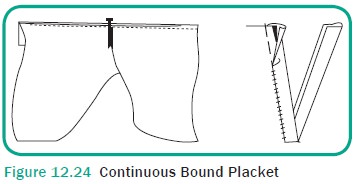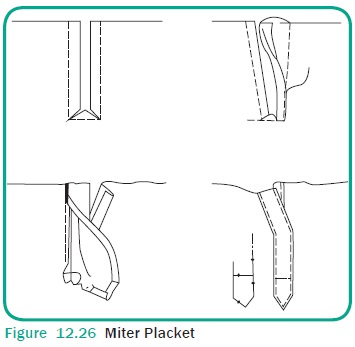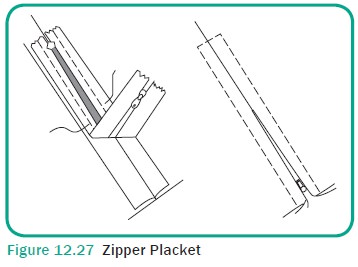Sewing - Types of Plackets | 11th Textiles and Dress Designing : Chapter 12 : Basic Sewing
Chapter: 11th Textiles and Dress Designing : Chapter 12 : Basic Sewing
Types of Plackets
Plackets
A placket is made either in an opening left on the seam or by creating a cut in a garment which enables one to wear or remove the gar-ment easily. The placket made on a seam is stronger and gives a better finish. The following points should be kept in mind while constructing a placket.
· A good placket should lay flat on the garment.
· A placket should not be thick and should not have gaps at the edges.
· The position of the placket should be easily accessible.
· The seams of the placket should be strengthened at the closed ends as it has to go through a certain amount of strain during wear.
· While choosing a placket the position of the placket, texture of the fabric, age and sex of the wearer along with the current fashion should be kept in mind.
Types of Plackets
Continuous Bound Placket
These plackets are made on a seam or a cut but should not be made on curved seams and bulky fabrics. This is also called as one-piece placket. They are suit-able for children’s dresses, undergarments like petticoats and sleeve openings where a cuff or band is used (Figure 12.24).

Method of Sewing Continuous Bound Placket
· To make a placket in a slash, cut a strip of fabric on the lengthwise grain.
· The cut should be 3 to 6 cm wide and 3 cm longer than twice the length of the openings.
· Match the centre of a long edge of the strip to the end of the slash edge, with right sides of garment and strips facing each other.
· Pull back the tip of the slash about 0.25 cm from the edge of the placket strip and pin it.
· Open the placket edges wide and attach to the strip by a line of tack-ing worked 0.25 cm from the edge of the strip.
· From the right side of the garment, machine over the tacking line from one end up to its midpoint.
· Keep the machine needle in the fab-ric, raise the pressure foot and move the fullness backward out to prevent fold created on the placket.
· Lower the presser foot and stitch along the opposite end of the opening.
· Press the seam edges towards the placket strip and fold under the free edge of the strip of 0.25 cm and crease.
· Fold the strip over the seam edge and hem it along the stitching line.
· Fold the strip under on the overlap section and tack it close to the seam.
· Tacking should be removed after fix-ing the fasteners.
Bound and Faced Placket or Two-Piece Placket
As the name indicates, this is done with two pieces of fabrics. This placket is com-monly used skirts, petticoats and back opening dresses. The overlap and under lap sides are finished with facing and binding respectively (Figure 12.25).

Method of Sewing Bound and Faced Placket
· Cut two separate strips of fabric, measuring 8 cm width for the over-lap and the other with 6 cm width for the under lap.
· The length of the strips should be 2.5 cm more than the length of the placket opening.
· The overlap and under lap sides are finished with the narrow and wide strips respectively.
· Care should be taken to maintain the stitching line of the seam along with the strips stitching line.
· The one inch extra length of the strips should extend below the placket opening.
· Crease the strip back over the seam and turn the free edges under the wrong side of the garment hem and finish the under lap.
· The completed bound side of placket should be 0.25 cm wide.
· Turn the overlap strip over com-pletely to the wrong side making 0.25 cm fold on the wrong side of the garment and hem neatly.
· Finish the placket by a row hand stitches on the wrong side catching the under and overlap together.
Miter Placket
Miter placket is mainly used in men’s shirts, sleeve opening and on neck openings for children’s garments where strength is the major requirement. It is also called as tai-lored placket (Figure 12.26).

Method of Sewing Miter Placket
· Prepare a strip on straight grain mea-suring 7 cm wide and exact length of the slit which is normally 12-15 cm for the under lap.
· Place the strip right side facing to match the end of the slit and with right side facing, sew about 5 cm to join the strip.
· Fold and machine along the stitch-ing line over the folded edge (0.25 cm) along the strip.
· Point the strip to about 2.5 cm wide.
· A strip measuring 5.5 cm wide and 3 cm longer than slit is cut for the overlap and this is placed on the seam line about 0.25 cm.
· Keep the right sides of the strip fac-ing the wrong side of garment and tack the short side of the strip to the free side of the placket opening on the seam line.
· Machine stitch and bring the overlap on the right side of the garment.
· Turn under the seam allowance and adjust the position of the strip so that overlap and under lap are together, sew it.
· Make a rows of top stitch on the strips and garment together turn around the point and downward till the opening.
· Then sew twice keeping the overlap and under lap in position on the gar-ment to form a square shape.
Zipper Placket
Zippers are plastic or metal rows with teeth like structures, which can be looped or unlooped by a runner. This is used to open or close the garment. It is attached on the placket. The market is filled with different types of zippers which can be matched based upon the side of placket opening and colour of the garment. Zippers are available in different colour and length (Figure 12.27).

Method of Sewing Zipper Plackets
· Cut the opening in the garment where the zipper has to be attached.
· Select the zipper according to the opening size.
· Towards the end of the cut make a short slit 0.25 cm wide diagonally on both sides (an inverted ‘V’ shape).
· Turn all the three raw edges to the wrong side and tack them.
· Sew a square piece of tape at the raw edge.
· Place the zipper on the sewen lap and stitch through the edges holding the fabric edge.
· Cover the zipper edges with a small square piece of tape, tack it first and then sew it.
· Hem the raw edges neatly to finish the zip.
Faced Placket Open
It is one of the simplest methods of fin-ishing a neckline. It is mostly used for infants, children and night dresses.
Method of Sewing Faced Placket Open:
· Cut a placket open for the required length at the centre back or front
· Place the facing piece right sides on the garment and make row of stitches
· Turn the facing to the wrong side and then top stitch
· Hem neatly to finish the facing
Related Topics